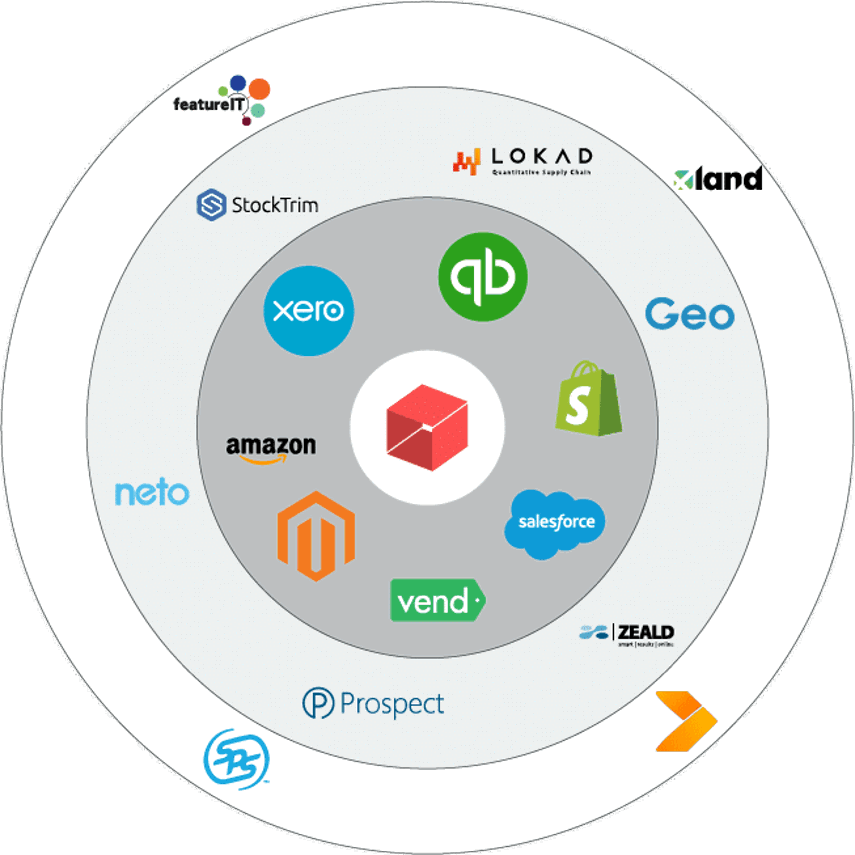
It’s hard for small business to survive and thrive in a competitive business world. Similarly, for start-ups looking to hit the ground running, there are multiple factors to consider.
For example, if you’re running a product-based business then inventory management is essential. From inventory tracking and safety stock levels to assembly, purchasing and shipping, getting inventory management right will increase your chances of success.
Let’s delve into some inventory management tips for small businesses and start-ups – plus cover off some of the general business best-practices that SMEs need to thrive.
Choose the right small business inventory management software
The very first thing that any small or start-up business can do to ensure good inventory management is to find a good inventory management software platform. With a whole ton of recent innovation in cloud computing solutions, even businesses with very limited capital can have access to cutting-edge software for a monthly subscription.
Software-as-a-Service (SaaS) is changing the way businesses access not only their software platforms but also their data. This is a great way to cut down on IT costs, as SaaS providers host the software at their end, as well as perform updates and upgrades.
- Learn more: Small Business Inventory Software
Accurate tracking
One of the key functions of inventory management is to track inventory across every node of the supply chain. The more accurate the tracking, the better it is. Accurate inventory tracking is an essential part of efficient and cost-effective inventory management.
The best software solutions work in real-time, often with barcoding and mobile technology. This works to provide the most accurate and meaningful inventory management available.
 Get your inventory management processes right from the start.
Get your inventory management processes right from the start.
Streamline and optimise from the start
Streamlining and optimisation of inventory practices doesn’t need to be left until your business has matured. In conjunction with good inventory management software, these techniques can be utilised from the start, saving you both time and much-needed capital. If you’ve got the budget, consider hiring an inventory management consultant to get you started.
Perform regular manual stock counts
While the best software utilises real-time stock accounting, the need for regular stock counts remains, especially if some of your products have a shelf life. Manual stock counts provide a way to reconcile what stock you really have with what stock you think you have. This is the only reliable way to check for obsolete, stolen or damaged stock.
Consider software that integrates with other platforms
For small businesses in particular, a safeguard against complicated and wasteful processes is to choose inventory management software that has integration possibilities. If you will be using accounting, POS or warehouse management systems, look for integration options that will make life easier. In order to have a sustainable business, there needs to be some tangible reality of harmony between the different parts of your systems and processes.
 Work out which software ecosystem suits you – and which software tools will integrate easily with each other.
Work out which software ecosystem suits you – and which software tools will integrate easily with each other.
Standardise early
It’s very common, and understandable, for new or small businesses to arrive at best practice via trial and error. This isn’t necessarily a bad thing, but even better than this is to put in place some consciously realised standardisation. Each process can be looked at in advance and mapped out for greater efficiency and process harmony.
Everything from the way orders are placed and stock is received, to how stock counts are carried out and sales are rung through can be assessed and standardised. While this may change over time, a plan in progress is better than no plan.
Organise your stock room or warehouse
A lot of money can get needlessly tied up or lost in the stock room or warehouse. It pays to organise this early. When well managed, a warehouse can operate in a streamlined manner, helping to ensure smart use of inventory and less stock wastage. For example, if there are products or parts that often get used together, then they need to be near each other in order to optimise processes.
3 reasons small businesses should implement an inventory management system
Inventory management can be a complex task for any business to master. Trying to optimise inventory stock levels can seem like an endless battle. Sometimes you end up with too much or too little. This trial and error saga continues for businesses who don’t have the right inventory management systems in place.
Small businesses often lag when it comes to setting up their inventory management systems properly. Historically, inventory management systems were big investments and reserved for large companies. However, with current technology, small businesses can afford inventory management systems. Not only will they appreciate the affordability, but they will be able to leverage and grow their company with these new systems. Here are a few key reasons why small businesses should look to implement inventory management systems.
1. Spreadsheets are old-school
Spreadsheets are outdated and can’t handle the modern demands of inventory management; they are cumbersome and take a long time to manage; there is a lot of manual effort that goes into tracking inventory stock for a spreadsheet. Not to mention, manual data entry is more susceptible to human error. Spreadsheets are not scalable. They will not adapt and grow with your business. Instead, they will hold you back and cause more harm than help. They don’t communicate with other systems easily and there are always problems with version control.
 Spreadsheets are outdated – avoid them from the start, and you'll scale more easily later.
Spreadsheets are outdated – avoid them from the start, and you'll scale more easily later.
2. The cloud has never been easier
Cloud-based inventory management software is simpler than ever. Without the cloud, inventory management can be a mess of suppliers, warehousing allocation systems and sales tracking. Often, these issues are dealt with independently of one another and rarely integrate.
The cloud solves these issues and has the connections in place to make data flow instantaneously. It can interpret information and provide real-time updates of inventory stock levels and current sales. It communicates with your accounting software and inventory management software. It also integrates with your business performance dashboard and can keep profit margins up to date.
3. Decision-making support
With cloud-based inventory management software, you’ll be able to analyse data much easier. This is important because it allows you to make informed decisions and to make them quickly. Since you can have access to real-time information, you can see what’s working and what’s not.
Inventory software can help with many facets of the business. It can determine when you need to order more inventory stock from suppliers and can automatically prompt you to make the order at the right time. Software can also help with forecasting. It can help predict what products to order and in what quantities. With a large amount of information available, it can run analytics from previous years. This can also help identify patterns in demand. Moreover, the cloud highlights what products sell better at what time of year and show how buying habits change. This means you can see which suppliers are offering the most competitive prices. This will help to save money and make decisions on which supplier you go with for those big orders.
The future of inventory control for small business
Small business inventory control is not what it used to be. Gone are the days where store owners and merchants would count their stock at the end of each day or use the punch card system introduced in the 1930s.
Inventory management has come a long way, products no longer need to be tracked down individually or orders and shipments written down on paper. But there is still room for small business to improve their processes and optimise inventory control.
So, what are the trends and technologies that are the future of small business inventory control?
 Cloud computing has many advantages over installed software.
Cloud computing has many advantages over installed software.
Cloud software systems
Cloud software solutions are already commonplace; most inventory systems are now cloud-based and can be integrated with other online products, allowing data to flow seamlessly between each system. Combining different cloud-based software can be a versatile and cost-effective solution for small business.
Cloud software is scalable which means it can expand to meet your needs as your business grows. With your data in the cloud, you can access it from any place, at any time via a mobile app on your smartphone or your laptop.
Many software applications also offer customisation to make the entire process more efficient. They can integrate with eCommerce platforms, automate shipping activities and provide detailed reports about your inventory stock.
Radio-frequency identification
Radio-frequency identification (RFID) has gained ground in small business inventory control and has been regularly used in warehouses, factories and retail stores for the past 15 years.
Using RFID, all product inventory and SKUs are tagged with microchips which when detected, automatically transmit information about product type, style, manufacturer and serial number to a central data collection platform. Meaning businesses no longer need to input data by hand because RFID readers can detect products and update databases instantaneously.
RFID tags can transmit information independently, allowing a much greater degree of automation, facilitating better monitoring of stock levels, reducing the risk of theft and providing greater inventory control.
Barcodes
As technology improved the barcode system became an efficient, affordable and widely adopted tool to replace tracking inventory by hand, with barcode scanners.
With this help from scanners, manual counting is replaced with a simplified, automated process that counts and keeps track of your inventory stock. Providing real-time updates every time a product is moved or sold.
Point of Sale systems
Point of Sale (POS) systems are big business for small business and can replace time-consuming manual billing systems. POS inventory management allows business owners to operate from more than one location, effectively keeping track of inventory at each store without the need to be on site.
Technology such as barcodes, scanners, touch screen payment portals and electronic payment options all help to provide an accurate and immediate record of sales as they are made. These tools at the point of sale allow managers real-time visibility of inventory stock and are particularly important for effective retail inventory management.
 Retail inventory management in particular depends on good POS technology.
Retail inventory management in particular depends on good POS technology.
4 ways Software-as-a-Service is giving small businesses the competitive edge
Small businesses are increasingly turning to Software-as-a-Service (SaaS) to help grow and scale their operations whilst keeping the costs associated with IT, infrastructure overheads, staffing and inventory management challenges to a minimum.
In terms of business software solutions, the playing field for small to medium businesses has now been leveled. It used to be the case that small businesses were relegated to the sidelines as their bigger, wealthier competitors invested in the expensive sophisticated onsite software solutions that gave them the competitive edge.
The sobering reality for many start-ups and small businesses looking to stake a bigger claim of market share was that without a hefty capital investment up front, they simply could not compete with businesses that were employing sophisticated software solutions to get ahead. Cloud-based SaaS services are changing all that.
Recent Gartner research suggests that 47% of organizations surveyed intend to move their Enterprise Resource Planning (ERP) solution over to cloud-based solutions within five years.
What this means is that the writing is officially on the wall for expensive – and in many cases outdated – traditional onsite software solutions. Businesses looking to gain a competitive edge and streamline their operations to optimal efficiency and profitability are inevitably going to turn to a cloud-based inventory management solution (like Unleashed!) to accomplish their objectives. Here are a few persuasive reasons why:
1. Better cash flow
Cash flow is the lifeblood of any business, but especially in the case of start-ups and small to medium sized businesses. Any move that restricts the free-flow of working capital, particularly at the early stages of business growth, can be fatal.
When a small business owner is faced with the prospect of having to pay between 70% to 90% higher up-front costs to install an on-premise ERP solution over a cloud-based SaaS solution, the choice in terms of the best way to move forward without compromising cash flow is obvious.
It makes far more sense to direct available capital and resources towards scaling the business for growth and capitalising on new opportunities as they arise than to invest heavily up front in costly software systems.
Cloud-based SaaS can be treated as a small, manageable operating expense that can be budgeted for accurately, and dealt with in a timely and predictable manner. What’s worth noting also is that the level of sophistication and integration of this software is surpassing (if it hasn’t already surpassed) the onsite systems at rapid pace.
 Cash flow remains the number one priority for small businesses.
Cash flow remains the number one priority for small businesses.
2. Access to sophisticated, top-tier software that is always current
Small businesses can now run their core operations using powerful, sophisticated and constantly evolving software that is accessible from anywhere with an internet connection.
By far the biggest obstacle facing on-site, standalone software solutions is their inability to adapt and evolve at the pace of business and technology growth. In many cases, onsite ERP systems simply don’t have the capability to integrate and operate with the latest data models which are constantly being updated, modified and employed in the cloud. Cloud based SaaS systems, by contrast, are always current.
3. Remote access and systems integration – anywhere, any time
There are no downloads or installations necessary with cloud-based SaaS. Customers can get started straight away, just by signing up to the service. From there on in everything is run off the cloud. Which means all relevant departments can be integrated for more effective synergy and communication, and access is remote and instantly available anywhere, any time – from any smart device.
Also, existing office systems and websites can be integrated with SaaS cloud ecosystems, too. This allows enhanced sharing of information between personnel and departments as well as improved collaboration – all of which has a positive impact on overall business efficiency and profitability.
4. Data is always backed up and available
One of the biggest concerns with onsite data storage is the possibility of servers being wiped out or theft, damage and destruction of hardware. The results in such cases can be devastating.
With cloud-based SaaS systems all data is safely stored on the service provider’s servers. This means that should some unforeseen disaster strike your physical business premises, your business can likely still function and operate efficiently remotely.
In particular the Covid-19 pandemic – and associated lockdowns – were a powerful illustration of how much an effective crisis response depends on easy access to data and systems.
6 tips for deploying a SaaS system in your SME
Cloud computing is proving to be an exciting and game-changing platform for small businesses, providing access to dynamic technology without the traditional outlay and ongoing IT costs. While the initial setup for many Software-as-a-Service (SaaS) solutions is simple and straightforward, this can sometimes be misleading. There is still the need for some careful planning, in-depth preparation and staff training. These should, as best business practices, be included in the Cloud Implementation Plan. If you’re unable to develop an implementation plan on your own, it can be a good idea to enlist the help of someone experienced in this field.
Here are 6 things to consider before jumping in and signing up to a SaaS provider.
1. Assess your business needs and goals
Small business owners often spend significant time during start-up learning as they go via the inevitable trial-and-error period. While this has its experiential benefits, it’s a good idea to sit down and assess what your business will need software-wise to be successful. If you’re thinking of utilizing a SaaS solution, make sure you read up on the available features, complete costs, integration opportunities and the capacity for upscale. Ideally you want your software to have the capacity to grow as your business grows, and while this is usually one of the strengths of SaaS, it pays to do your homework before signing up. Software comparison sites such as Capterra and GetApp are a great place to start.
2. Make sure you know what you are getting
SaaS providers make it easy for businesses to sign-up and get started. While this is largely a good thing, it has the potential to backfire if you haven’t read through the necessary backend information. Make sure you ask to see both the terms and conditions and Service Level Agreement before signing up. The SLA should include everything the supplier is agreeing to provide and what measures they have in to place to ensure delivery. It’s also a good idea to check what measures they have in place in case of any failure to provide. In Unleashed’s case you can find all of this information on our Terms and Conditions page.
3. Put in place sufficient platform training
Before going live, make sure your staff (and you) know how to use the software. While many SaaS solutions are simple to use, there should still be a plan, with accountability, to make sure everyone’s up to scratch. It’s important to remember that whatever training you put in place needs to cater to the lowest common denominator – some people will need little training while others may need a lot.
 Get maximum value from your software by training key staff – and check what self-service training your provider has available.
Get maximum value from your software by training key staff – and check what self-service training your provider has available.
4. Check for hidden costs
Make sure you check out any possible hidden costs and plan accordingly. There can be some lurking in the extra features of a product or in the cost of integration with existing software. It’s a good idea to shop around before settling on a provider, especially if you want to integrate SaaS with your in-house software systems.
5. Ensure uninterrupted Internet access
Perhaps one of the biggest downsides of SaaS technology is the heavy reliance on the Internet connection itself. It’s vitally important to make sure that your Internet provider can ensure uninterrupted Internet access; it’s a good idea to ask for a contract that reflects this.
6. Check that you own the rights to your stored data
As some (or all) of your data will be stored by the provider, it’s important to ensure that you ultimately own the rights to it. This should be part of your Service Level Agreement along with what safeguards are in place in the event of data recovery.
8 ways to reduce costs and lift efficiency in a small business
One of the challenges of managing a small to medium sized business is the need to optimise your organisation, and run it as efficiently as possible.
Unlike larger companies that have greater access to financial backing, and that enjoy economies of scale, small business owners need to be especially resourceful with cost management, and their operational and inventory control techniques. They need to streamline their business, so they remain viable even in a fickle economy.
Often small businesses turn to big ticket items when cutting costs. For example reducing wage spend by letting people go can indeed cut costs. However, this will also cut into company morale and work ethic too. In a small business, these changes can make a huge impact, but not always for the better. Instead, let’s consider simpler ways to reduce costs across a small business.
Here are 8 ways efficiencies in time, labour, inventory control and running costs can be achieved in order to streamline your day-to-day operations.
1. Target overheads
Overhead costs for small businesses can be significant. Particularly for brick and mortar establishments that incur rental fees, energy bills and inventory holding costs.
What tasks are you currently performing that contribute to overhead costs and detract from revenue-generating activities? Check if any of the tasks can be streamlined with technology or by outsourcing to reduce overheads and improve your business.
Are you using services that can be bundled to provide cost savings? For example voice over internet protocol, or VOIP systems allow businesses to make calls from anywhere there is a broadband connection.
Using a single source provider for communication services such as telephone systems and internet connectivity can help to reduce overhead costs.
 Outsourcing, for example to a 3PL, can save small businesses a lot.
Outsourcing, for example to a 3PL, can save small businesses a lot.
2. Outsource where you can
It’s common for manufacturers to outsource various components of production to achieve a significant decrease in assembly costs. There are however, other functional areas of business that can be successfully outsourced such as information technology, marketing, accounting and human resources.
Managing employees can be a time-consuming endeavour for small business owners and technology can help simplify the process of maintaining accurate employee records, tracking hours worked, managing payroll, leave entitlements and reporting employment taxes.
Technology however, is no replacement for the hands-on personal component necessary for effective human resource management. Recruitment agencies and HR consultants can be contracted to manage staff employment, training and where necessary, termination.
3. Get rid of paper
Technology is in and paper is out. It’s antiquated, costly and becoming an overall burden as more and more business moves into the purely digital space. The days of paper, ink, and envelopes are coming to an end. Make your work digital and see how the automation not only saves you money on printers, paper stock and ink, but saves you time by streamlining processes like invoicing and bill payments.
4. Hang up the landline
Landlines are costly and old-fashioned. The modern work forces operate on mobile phones, which gives them constant access to information and the ability to be contacted anywhere. The landline does not serve the same purpose as it used to, so why should you still be paying for it?
5. Find software ecosystems
Rather than buying a software platform for your invoicing, plus a software system to track inventory, and then a software system that keeps all of your contacts and suppliers in order, choose a software ecosystem that lets you connect all of these functions.
If you choose the right online inventory management system for example you’ll be able to connect your invoicing, accounting, CRM and fulfilment tools into a single connected ‘stack’ that will make your operation infinitely more efficient.
6. Decrease travel costs
Letting your employees work remotely is a smart way to reduce their transportation costs, leaving them with more money (and time). And if you build remote working into a formal policy the business will also be able to reduce its utility costs – think about things like car parking, heating, electricity and water, and even the number of desks you’ll need to provide.
Similarly, if you have big meetings in different locations, see if a virtual meeting system is available. Saving on air travel is a significant way to reduce costs for a small business. Since the lockdowns that followed the Covid-19 outbreak virtual meetings have become the norm, so ensure you enjoy the cost savings that can come with this approach.
 Social media advertising tools are highly cost effective if you know how to use them.
Social media advertising tools are highly cost effective if you know how to use them.
7. Use social media advertising to win leads and new business
Running a team of full team of primary sales executives to book leads for your sales consultants is an extraordinarily expensive and time-consuming way of generating new business.
Today, small businesses have the ability to target leads with incredible accuracy thanks to sometimes spookily sophisticated advertising algorithms.
With the help of a few well-targeted Google, LinkedIn or Facebook ads you can generate a steady stream of visitors to your website, where inexpensive plug-ins such as Calendly allow interested potential customers to book time in with your consultants directly.
8. Target your biggest costs first
Look at your business and production processes and identify which are creating the biggest problem for you financially. These might include production, marketing and advertising, administration and facilities maintenance.
Figure out which components are the most expensive and devise a plan accordingly. If marketing is draining your financial resources, consider changing your approach and trying out cheaper alternatives.
A good way to start is to assess your profit and loss statement for the past six months. This will give you full oversight into your expenses, and you will be able to rank them from highest to lowest. Next, devise cost-saving strategies for the areas where your business will get the biggest return.
A SME’s guide to stress-free inventory management during holiday season
With the holiday season representing as much as 40 per cent of annual sales for some retailers, it is vital to minimise the risks of having not enough - or having too much - inventory stock during the holidays.
When items are quickly going in and out of stock and returns are being made in larger volumes than usual, small businesses that do not use an automated way to keep up with their inventory management stand to lose a large percentage of their annual revenue.
To help ensure your business does not miss out on this large flow of income and to enjoy a relatively stress-free holiday season, follow this useful holiday inventory management guide for small businesses.
Prepare before the holiday season begins
Reduce the workload by getting automated
The first step is to build a solid inventory management foundation to support your business. The sheer volume of stock that moves around during the holidays takes extra time to track, and you may have even less time to manage your stock because you’ll be extra busy selling. You can reduce the amount of time you’ll need to spend tracking inventory stock with a simple solution: invest in inventory software prior to the holiday rush.
Calculate how much stock you need
Demand forecasting is a critical step in getting your inventory ready for the holiday season. You should look at your historic sales data and any current trends carefully to predict what will sell during the busy season. Pay close attention to inventory stock behaviour during holidays of the previous years. Identify similarities between your present economic situation and business environment with periods in the past, as this will help predict the amount of stock needed.
Place your orders early
Once you’ve forecasted the quantity of stock needed, it is recommended that you order it as early as possible ahead of the holiday season rush. Not only will this help you get your ducks all lined up in a row, but also new statistics show that people are beginning to shop earlier for the holiday season – such as October!
 Seasonal inventory control is a challenge for small businesses.
Seasonal inventory control is a challenge for small businesses.
During the holiday season
Set up an inventory stock replenishment plan
If you’re manually tracking inventory items with a spreadsheet or paper method, your business is missing out on some time and money saving features. Prevent items from going out of stock by using barcode scanners in your point of sale system and integrating them with inventory management software. Use your inventory software to create and monitor alerts when an item is getting low, then you can reorder before it runs out – easily preventing lost sales due to stock outs.
Process accurate returns
The reality is people who receive gifts want to return an item and often without a receipt. It is really imperative to have a convenient small business returns policy. However, in light of your returns policy, to cater returns accurately try applying “required for return” barcode stickers on gift items. Then, a gift recipient only needs to keep that barcode sticker on the item, and the gift giver won’t need to worry about keeping track of a gift receipt. By making returns easy, pleasant and quick, you can create positive experiences with customers that build trust and encourage them to shop with you again.
After the holiday season
Sell your excess stock now!
To avoid accumulating obsolete stock you need to act quickly. There’s a real risk in holding on to items thinking you may still get a premium price for them.
A few tips that are especially relevant to retail inventory management are:
- Move old stock items to a more prominent location, add new visuals and group them with fast-moving items
- Try discounting by moderately re-pricing items. If these items still do not sell, try more aggressive markdowns
- Try hosting or participating in pop-ups and special events
- Items older than a year are typically considered dead stock. If they cannot be sold, trying using these methods to get rid of dead stock
Small business & inventory management: final thoughts
Both starting, and running a small business can be a seriously challenging job. There are many factors to consider and many decisions to weigh up. All industries are competitive but with the right preparation and planning, success and sustainability are possible – and accurate inventory management can help you get there.
To learn everything you need to know about inventory management see our free series of comprehensive guides here.
